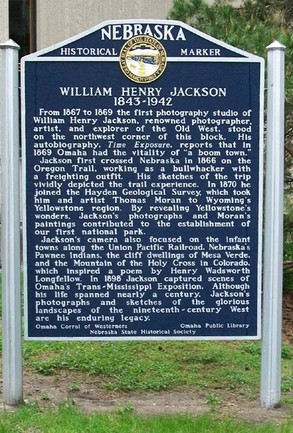Historical Marker: William Henry Jackson
Introduction
Text-to-speech Audio
Between 1867-1869, renowned American photographer William Henry Jackson (1843-1942) operated his first studio at this location. His photographs of Western landscapes, along with paintings by Thomas Moran, helped convince the federal government to establish Yellowstone National Park, the first national park created in the country (he and Moran were part of an expedition of an 1870 U.S. Geological Survey to the West which explored Wyoming's portion of the park). His career took him to Mexico, Asia and the Pacific. He continued to photograph until the very end of his life in 1942.
Images
The historical marker, which is located on the grounds of Dale Clark Library. Photo by: William Fischer, Jr.

Backstory and Context
Text-to-speech Audio
Jackson's career began in 1858 when he started to work as photograph retouch artist. From there he traveled to Nebraska via the Oregon Trail, working for a freight company as an oxen driver. Along the way he made sketches of what he saw. In addition to working on the geological survey, Jackson explored Colorado (basing himself in Denver), traveled to various places in Asia and the Pacific, and lived and worked in Detroit. He made is way to New York City during his "retirement years" where he continued to take pictures. His work went beyond landscapes. He also photographed people and cultural remains, such as the cliff dwellings of the Mesa Verde.
Sources
"About the Collection." Brigham Young University. Accessed December 5, 2016. https://lib.byu.edu/collections/william-henry-jackson-collection/about.
"William Henry Jackson." The Historical Marker Database. Accessed December 5, 2016. http://www.hmdb.org/marker.asp?marker=35193.
"William Henry Jackson." The Historical Marker Database. Accessed December 5, 2016. http://www.hmdb.org/marker.asp?marker=35193.
